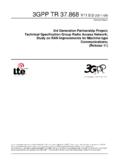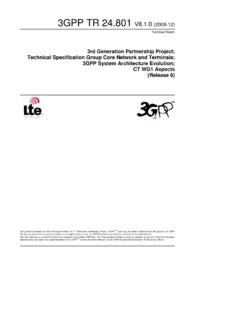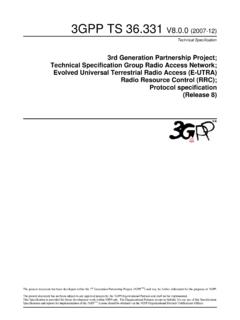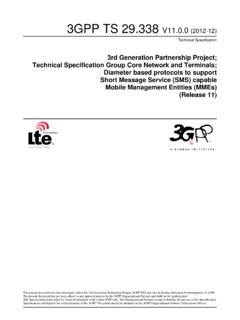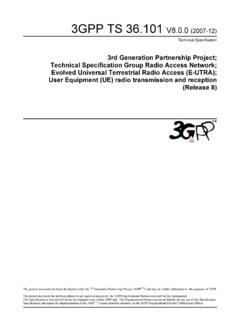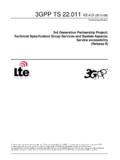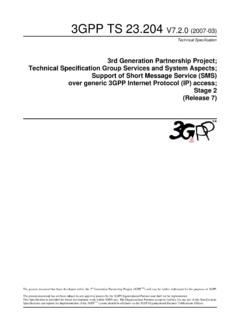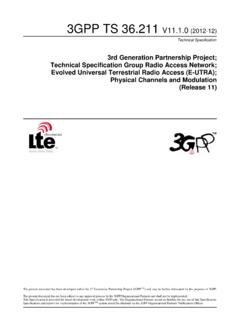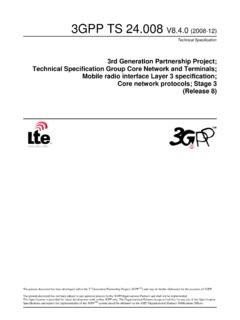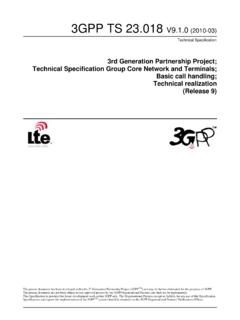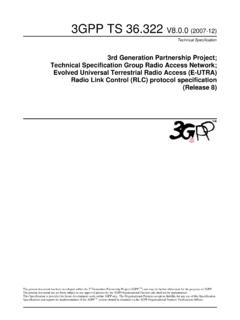Transcription of 3GPP TS 36 - 株式会社QT
1 3 GPP TS (2008-05). technical specification 3rd Generation Partnership Project;. technical specification Group Radio Access Network;. Evolved Universal Terrestrial Radio Access (E-UTRA);. Base Station (BS) radio transmission and reception (Release 8). The present document has been developed within the 3rd Generation Partnership Project (3 GPP TM) and may be further elaborated for the purposes of 3 GPP. The present document has not been subject to any approval process by the 3 GPP Organizational Partners and shall not be implemented. This specification is provided for future development work within 3 GPP only. The Organizational Partners accept no liability for any use of this specification . Specifications and reports for implementation of the 3 GPP TM system should be obtained via the 3 GPP Organizational Partners' Publications Offices. Release 8 2 3 GPP TS (2008-05).
2 Keywords UMTS, BSS, radio 3 GPP. Postal address 3 GPP support office address 650 Route des Lucioles - Sophia Antipolis Valbonne - FRANCE. Tel.: +33 4 92 94 42 00 Fax: +33 4 93 65 47 16. Internet Copyright Notification No part may be reproduced except as authorized by written permission. The copyright and the foregoing restriction extend to reproduction in all media. 2008, 3 GPP Organizational Partners (ARIB, ATIS, CCSA, ETSI, TTA, TTC). All rights reserved. 3 GPP. Release 8 3 3 GPP TS (2008-05). Contents Foreword ..6. 1 Scope ..7. 2 References ..7. 3 Definitions, symbols and abbreviations ..7. Definitions .. 7. Symbols .. 8. 9. 4 General ..9. Relationship between minimum requirements and test 9. Base station 9. Regional requirements .. 10. 5 Frequency bands and channel 10. Channel bandwidth .. 10. Frequency bands .. 11. Channel arrangement.
3 12. Channel spacing .. 12. Channel 12. Carrier frequency and EARFCN .. 12. 6 Transmitter characteristics ..13. 13. Base station output 14. Minimum requirement .. 14. Output power dynamics .. 14. Minimum requirements .. 14. Minimum requirements .. 15. Transmit ON/OFF 15. Transmit OFF power .. 15. Minimum 15. Transmitted signal quality .. 15. Frequency 15. Minimum 15. Error Vector 15. Time alignment between transmitter 16. Minimum 16. Minimum requirements .. 16. Unwanted emissions .. 16. Occupied 16. Minimum 16. Adjacent Channel Leakage power Ratio (ACLR).. 17. Minimum 17. Operating band unwanted 18. Minimum requirements (Category A) .. 19. Minimum requirements (Category B) .. 20. Additional requirements .. 22. Transmitter spurious emissions .. 23. Mandatory Requirements .. 23. Spurious emissions (Category A) .. 23. Minimum 23. Spurious emissions (Category B).
4 24. Protection of the BS receiver of own or different 24. Minimum 24. Co-existence with other systems in the same geographical area .. 24. 3 GPP. Release 8 4 3 GPP TS (2008-05). Co-location with other base 27. Transmitter intermodulation .. 29. Minimum requirement .. 29. 7 Receiver 30. Reference sensitivity level .. 30. Minimum requirement .. 30. Dynamic 31. Minimum requirement .. 31. In-channel 31. Minimum requirement .. 32. Adjacent Channel Selectivity (ACS) and narrow-band blocking .. 32. Minimum requirement .. 32. 33. General 34. Co-location with other base stations .. 34. Receiver spurious emissions .. 36. Minimum requirement .. 36. Receiver 36. Minimum requirement .. 36. 8 Performance requirement ..37. 37. Performance requirements for 38. Requirements .. 38. Performance requirements for PUCCH .. 44. DTX to ACK 44. ACK missed detection requirements for PUCCH format 44.
5 Performance requirements for PRACH .. 45. PRACH False alarm probability .. 45. PRACH missed detection requirements .. 45. Annex A (normative): Reference measurement channels ..46. Fixed Reference Channels for reference sensitivity and in-channel selectivity (QPSK, R=1/3) ..46. Fixed Reference Channels for dynamic range (16 QAM, R=2/3) ..47. Fixed Reference Channels for performance requirements (QPSK 1/3) ..47. Fixed Reference Channels for performance requirements (16 QAM 3/4) ..48. Fixed Reference Channels for performance requirements (64 QAM 5/6) ..48. PRACH Test 48. Annex B (normative): Propagation Static propagation Multi-path fading propagation High speed train condition .. 51. Annex D (normative): Environmental requirements for the BS equipment ..54. Annex E (normative): Error Vector Magnitude ..55. Reference point for 55. Basic unit of 55.
6 Modified signal under test .. 56. Estimation of frequency 56. Estimation of time 56. Window length .. 56. Estimation of TX chain amplitude and frequency response parameters .. 57. Averaged 58. 3 GPP. Release 8 5 3 GPP TS (2008-05). Annex F (informative): Change history ..59. 3 GPP. Release 8 6 3 GPP TS (2008-05). Foreword This technical specification has been produced by the 3rd Generation Partnership Project (3 GPP). The contents of the present document are subject to continuing work within the TSG and may change following formal TSG approval. Should the TSG modify the contents of the present document, it will be re-released by the TSG with an identifying change of release date and an increase in version number as follows: Version where: x the first digit: 1 presented to TSG for information;. 2 presented to TSG for approval;. 3 or greater indicates TSG approved document under change control.
7 Y the second digit is incremented for all changes of substance, technical enhancements, corrections, updates, etc. z the third digit is incremented when editorial only changes have been incorporated in the document. 3 GPP. Release 8 7 3 GPP TS (2008-05). 1 Scope The present document establishes the minimum RF characteristics and minimum performance requirements of E-UTRA. Base Station (BS). 2 References The following documents contain provisions which, through reference in this text, constitute provisions of the present document. References are either specific (identified by date of publication, edition number, version number, etc.) or non-specific. For a specific reference, subsequent revisions do not apply. For a non-specific reference, the latest version applies. In the case of a reference to a 3 GPP document (including a GSM document), a non-specific reference implicitly refers to the latest version of that document in the same Release as the present document.
8 [1] 3 GPP TR : "Vocabulary for 3 GPP Specifications". [2] ITU-R Recommendation : "Unwanted emissions in the spurious domain". [3] ITU-R Recommendation : "Measurement uncertainty as it applies to test limits for the terrestrial component of International Mobile Telecommunications-2000". [4] 3 GPP TS : "Evolved Universal Terrestrial Radio Access (E-UTRA); Base Station (BS). conformance testing". [5] ITU-R recommendation : "Spectra and bandwidth of emissions". [6] 3 GPP TS : "Base Station (BS) radio transmission and reception (FDD)". [7] 3 GPP TS : "Base Station (BS) radio transmission and reception (TDD)". [8] 3 GPP TR : "RF system scenarios". 3 Definitions, symbols and abbreviations Definitions For the purposes of the present document, the terms and definitions given in TR [1] and the following apply. A. term defined in the present document takes precedence over the definition of the same term, if any, in TR [1].
9 Carrier: The modulated waveform conveying the E-UTRA or UTRA (WCDMA) physical channels Channel bandwidth: The RF bandwidth supporting a single E-UTRA RF carrier with the transmission bandwidth configured in the uplink or downlink of a cell. The channel bandwidth is measured in MHz and is used as a reference for transmitter and receiver RF requirements. Channel edge: The lowest and highest frequency of the E-UTRA carrier, separated by the channel bandwidth. DL RS power: The resource element power of Downlink Reference Signal. Maximum output Power: The mean power level per carrier of the base station measured at the antenna connector in a specified reference condition. Maximum throughput: The maximum achievable throughput for a reference measurement channel. 3 GPP. Release 8 8 3 GPP TS (2008-05). Mean power: When applied to E-UTRA transmission this is the power measured in the channel bandwidth of the carrier.
10 The period of measurement shall be at least one subframe (1ms), unless otherwise stated. Measurement bandwidth: The bandwidth in which an emission level is specified. Occupied bandwidth: The width of a frequency band such that, below the lower and above the upper frequency limits, the mean powers emitted are each equal to a specified percentage /2 of the total mean power of a given emission. Output power: The mean power of one carrier of the base station, delivered to a load with resistance equal to the nominal load impedance of the transmitter. Rated output power: Rated output power of the base station is the mean power level per carrier that the manufacturer has declared to be available at the antenna connector. RE power control dynamic range: The difference between the power of a RE and the average RE power for a BS at maximum output power for a specified reference condition.
